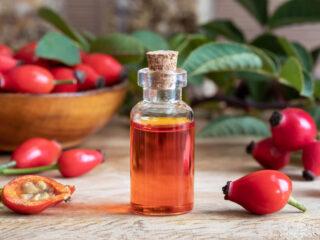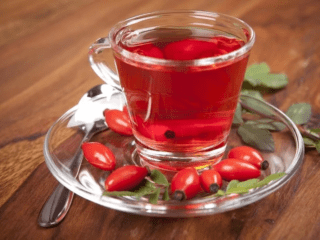Content
Rose hips are a useful plant with numerous medicinal properties. The green parts, fruits and roots of the culture are used in the preparation of decoctions and infusions; dosages must be observed when consuming.
Botanical description of the May rosehip plant
May rose, cinnamon rose, or May rose (Rosa majalis), is a perennial shrub up to 2 m tall. It has thin shoots with shiny red-brown bark, brownish in adulthood. The branches are covered with hard sickle-shaped spines, usually located in pairs at the base of the leaf petioles, and straight thin needles.May rosehip belongs to the Rosaceae family, although in appearance it differs from the decorative garden crop.

There are usually no thorns on the flowering shoots of the May rosehip
From May to July, the shrub bears large five-petalled buds with shades ranging from pale red to deep wine. In the center are numerous stamens and pistils, as well as styles that form the woolly head of the flower.
May rose hips
The fruits of the May rose hips are spherical or elliptical in shape, covered with smooth orange or red skin. The pulp of the berries is fibrous, containing numerous hard and hairy fruits - small nuts. Ripening occurs in August and September.
May rosehip leaves
From the morphological description of the May rose hip it follows that the plant has odd-pinnate leaves of a complex shape with 3-7 pairs of elliptical leaflets with serrations along the edge. The plates are located on pubescent petioles; they are bright green on top and bluish below with slight pubescence.
Rosehip cinnamon monocotyledonous or dicotyledonous
Among the characteristics of the May rose hips, one can note the reticulate venation of the leaves and the number of petals, a multiple of five. Due to these structural features, the shrub is classified as a dicotyledonous plant.
Where does the rosehip grow?
May rosehip is widespread throughout Eurasia and Scandinavia. In Russia you can find it in the European part and in Siberia, in the Baikal region, Altai and Kazakhstan. Typically, shrubs choose edges, clearings and clearings, meadows and ravines, and floodplain forests to live in.
It is found both singly and as part of thickets, often adjacent to honeysuckle and prickly rose hips. Prefers to grow in sunny areas, but tolerates partial shade.
Chemical composition of rose hips
Photos of cinnamon rosehip and its valuable properties are of interest to traditional medicine due to its rich composition. The fruits and green parts contain:
- vitamin A;
- ascorbic acid;
- manganese and copper;
- tannins;
- folic acid;
- thiamine and riboflavin;
- vitamins E and K;
- potassium, iron and magnesium;
- pectins;
- malic and citric acids;
- chromium, zinc and fluorine;
- calcium;
- thiamine
Vitamin C gives rosehip fruits special value - it is present in berries twice as much as in currants.
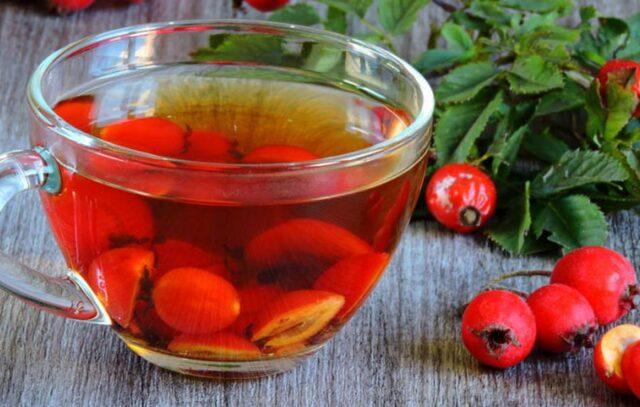
May rosehip improves blood composition and strengthens the walls of blood vessels
Medicinal properties of rose hips
When used in moderation, rosehip brings significant benefits to the body. In particular, the plant:
- has astringent properties and helps cope with diarrhea;
- has a pronounced anti-inflammatory effect against infections;
- promotes recovery and relieves fever during colds;
- eliminates spasms and helps with joint pain and headaches;
- has a hypotensive effect and reduces blood pressure;
- promotes the removal of edema and improves kidney function;
- fights the bacterial process in sore throat and dental diseases;
- stimulates the immune system and increases the overall resistance of the body;
- supports healthy digestive function.
Rosehip-based products have a beneficial effect on reproductive functions in men and women. You can use decoctions and infusions of the plant to get rid of excess weight, as well as to slow down the aging process.
Methods of preparation and use
Traditional medicine uses the May cinnamon rosehip to prepare light teas and concentrated medicinal decoctions. When used in small dosages, the products improve well-being in just a few days.
Tea
Tea based on rose hips is recommended for use in case of sluggish digestion and weakened immunity. It is made according to the following recipe:
- Measure out 30 g of dried rose hips and grind them thoroughly.
- Mix with 20 g of nettle leaves and 10 g of raspberries.
- Pour 400 ml of boiling water into a thermos into a large spoon of the resulting mixture.
- Close the lid and leave the drink for 15 minutes.
Strained tea can be consumed twice a day, one glass at a time; it is permissible to add honey to the drink. You can take the product for up to three months in a row.

Tea with rose hips improves appetite
Infusion
May rosehip infusion has good hypotensive and anti-edematous properties. It is prepared according to this recipe:
- Pour 200 g of dry berries of the plant into a thermos.
- Pour in 1 liter of hot water.
- Keep covered for at least two hours.
- After the period has passed, filter the drink.
The infusion can be drunk 150-200 ml three times a day.
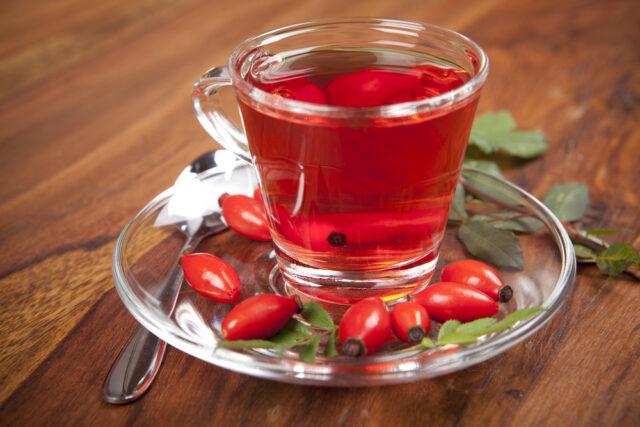
May rosehip infusion promotes expectoration when coughing
Decoction
From the May rose, or May rose, you can prepare a decoction with good anti-cold properties. The algorithm looks like this:
- Bring 400 g of water to a boil over high heat.
- Add 60 g of dry or fresh rose hips.
- Reduce heat to low and boil berries for five minutes.
- Cool under the lid and filter.
You need to take the decoction 30 ml three times a day. The product has pronounced anti-inflammatory properties and lowers fever.

You can drink rosehip decoction for up to ten days in a row.
Extract
You can buy a plant extract at the pharmacy. It is produced industrially - first, fresh berries are soaked and evaporated, and then the resulting syrup is dried to a foam and ground into powder.
In terms of valuable properties, the purchased product is not inferior to ordinary decoctions and infusions based on fruits. But preparing drinks using it is easier - the extract is simply stirred in hot or warm water. The resulting drink is taken to stop bleeding, prevent anemia and anemia, and strengthen the immune system.

Rosehip extract accelerates the flow of bile and helps cleanse the liver
Application of rose hips
Traditional medicine uses rosehip flowers, its leaves and fruits to treat a wide variety of diseases. Decoctions and infusions help to quickly cope with acute infectious processes and alleviate the course of chronic ailments.
For diabetes
The beneficial May rosehip lowers blood sugar levels and normalizes the functioning of the pancreas. To improve the condition of diabetes, the following medicine is prepared:
- Pour 20 g of dried fruits of the plant into an enamel pan.
- Pour 500 ml of boiling water.
- Place in a water bath for 20 minutes.
- Remove from heat and leave covered for eight hours.
The strained decoction is consumed up to four times a day on an empty stomach, 50 ml. Sugar should not be added to the drink.
For pancreatitis
The medicinal plant relieves irritation of the pancreas, soothes pain and improves the production of digestive enzymes. During the period of calm progression of the disease or at the first symptoms of exacerbation, you can use the root system of the May rosehip to prepare a decoction. The recipe looks like this:
- Measure out 50 g of dry roots and chop thoroughly.
- Pour 250 ml of hot water into the raw material.
- Place in an enamel container over low heat and boil for 20 minutes.
- Strain through cheesecloth.
You need to drink the drug three times a day, using a large spoon.
For gastritis
You can use products based on rose hips for gastritis with low acidity. The plant normalizes the production of gastric juice, speeds up the digestion of food and eliminates heaviness in the stomach after eating.
The medicine is made as follows:
- About 100 g of dried fruits are properly crushed.
- Pour the resulting powder into 1 liter of water.
- Boil over low heat for three minutes after boiling.
- Cool under the lid and strain.
You need to drink 200 ml three times a day shortly before meals.
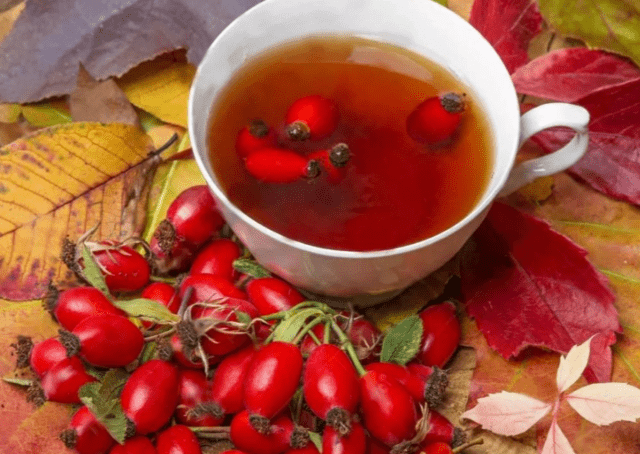
In case of hyperacid gastritis, rose hips should not be consumed - it will cause irritation of the mucous membranes
For gout
The strong anti-inflammatory properties of May rose hips relieve joint pain due to gout and promote the removal of salts. The recipe for preparing the decoction is as follows:
- Several young shoots of the plant are crushed.
- Measure out 100 g of raw material and pour in 1 liter of liquid.
- Bring to a boil and boil for half an hour over moderate heat.
- Cool and strain to remove sediment.
The product must be drunk in several doses throughout the day. Use the decoction on an empty stomach or a couple of hours after meals.
For intestinal colitis
The astringent and analgesic properties of the plant help with inflammation of the colon. For medicinal purposes the following remedy is prepared:
- Grind 20 g of dried fruits of the plant.
- Steam 300 ml of fresh boiling water.
- Keep covered for four hours.
- Filter from sediment.
The infusion should be taken 100 ml twice a day.
To cleanse the liver
The plant helps remove toxins from the body and cleanses the liver well after poisoning or long-term use of medications. Traditional medicine recommends the following recipe:
- A large spoonful of rose hips is combined with an equal amount of oats.
- Pour the ingredients into a blender and grind thoroughly.
- Fill the raw material with 1 liter of hot water in a thermos.
- Leave covered for 12 hours to swell.
- The resulting viscous mass is filtered through cheesecloth and squeezed.
The drug is taken warm on an empty stomach, 15 ml three times a day. In total, treatment is continued for ten days, then a break is taken for three weeks and the course is repeated twice more.
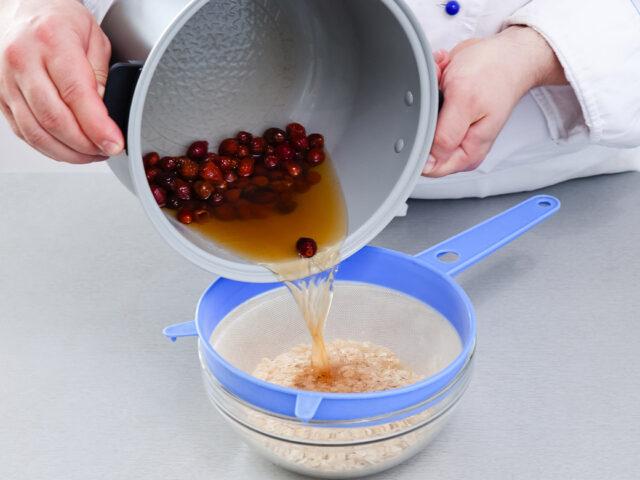
An infusion of rose hips and oats improves the functioning of the spleen and pancreas
For hemorrhoids
You can use the beneficial May rosehip externally. For hemorrhoids, homemade ointment has a good effect, and you can do it like this:
- Melt 10 g of natural propolis in a water bath.
- Mix with 100 g of purchased rosehip oil.
- Mix the ingredients thoroughly.
- After cooling, put the mixture in the refrigerator.
The thickened ointment is applied to the anus once a day. The procedures are best performed in the evenings; treatment continues for two weeks.
For hypertension
May rosehip helps reduce blood pressure in hypertension and relieves headaches. For treatment, prepare the following infusion:
- Measure out two large spoons of dry berries of the plant.
- Steam the raw material with a glass of boiling water and cover with a lid.
- Leave for two hours until cool.
The finished product is filtered and taken on a full stomach, half a glass three times a day.
For cholecystitis
Brown May rose hips improve the flow of bile and relieve inflammation in cholecystitis. The following drug is prepared for therapy:
- Grind dry fruits in a volume of 30 g.
- Steam the powder with a glass of hot water.
- Leave covered overnight.
- Strain through cheesecloth.
The product is consumed twice a day, 150-200 ml.

If you have large gallstones, you should not use rosehip infusion.
At low pressure
Rose hips are mainly used to lower blood pressure. But based on the plant, you can prepare a drug that will be beneficial for hypotension. The recipe looks like this:
- A large spoonful of dry rosehip berries is crushed and combined with an equal amount of sage herb.
- Pour the collection with 500 ml of hot water and leave for an hour under the lid.
- Strain before use.
The infusion should be drunk up to five times a day, 15 ml. If desired, you can add a little natural honey to the drink to improve the taste.
Contraindications
The May rosehip plant does not always benefit the body. It is necessary to avoid using decoctions and infusions:
- for individual allergies;
- for stomach ulcers and acute pancreatitis;
- with a tendency to thrombosis;
- with an excess of vitamin C in the body;
- for inflammatory diseases of the myocardium;
- with severe pathologies of the liver and gall bladder;
- for acute inflammation of the kidneys and urinary tract.
Products based on rose hips are not offered to children under two years of age - drinks can cause allergies or digestive upset. For adults, it is extremely important to adhere to dosages during treatment, since in excess quantities the plant leads to diarrhea, nausea, skin rashes, dizziness and heart rhythm disturbances.
Collection and preparation
May rosehip is a shrub that is often grown for decorative purposes in the country. Therefore, you can collect medicinal raw materials both in an ecologically clean area in nature and on your own plot.
Plants are harvested throughout the warm season. The fruits are removed from the shoots in the fall upon reaching maximum ripeness; flowers and leaves are collected in early summer during the decorative period. The raw materials are laid out on a tray under a canopy or indoors, depending on the weather, and with good ventilation they are dried until the moisture has completely evaporated. After this, the blanks are poured into fabric bags or glass jars and stored in a dark place with a temperature no higher than 25 °C.
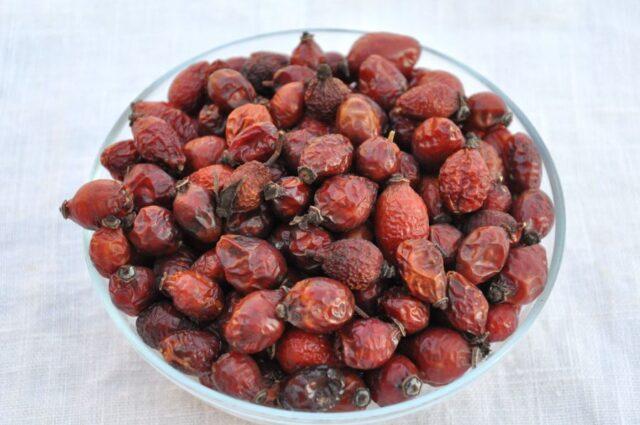
May rosehip retains valuable properties for two years
Conclusion
May rose hips have not only decorative, but also medicinal value. The plant is used in the treatment of cardiovascular and digestive ailments, inflammation and to strengthen the immune system.
